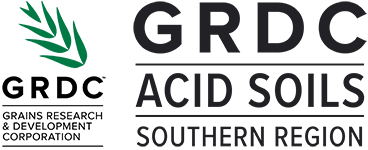ABOUT
Project Aim
By June 2025, growers and advisers in South Australia, Victoria and Tasmania are provided with improved understanding of the development of topsoil and subsoil acidity, limitations to crop profitability, and improved management practices to address this emerging constraint.
By 2027 the aim of this and other projects is to collectively reduce the current cost of soil acidity in the southern region by 25%.
Project duration
1 June 2022 – 30 June 2025
Background
Soil acidity has been a constraint to crop production in Australia for many decades, especially on sandy soils where pH drops rapidly. Low soil pH reduces the availability of nutrients for plant growth and can increase aluminium in the soil solution that is toxic and can impair root growth. In addition, the Rhizobia in most pulses is particularly sensitive to soil acidity.
General increases in crop productivity due to improved genetics and management, plus the expansion of pulses and increased fertiliser nitrogen inputs are expected to increase soil acidification rates, especially in intensively cropped areas growing acid-sensitive lentils, chickpeas, faba beans and barley.
About 2.0M ha of cropping land in South Australia (SA) currently has surface soil acidity (0-10cm < pH 5.5) or is considered acid prone, and this area is expected to double over the next 40 years if remedial action is not taken. Acid soils in Victoria were estimated at around 3M ha in 2015.
Subsoil acidity is difficult to correct with lime applications because of its low solubility and movement, and is becoming more common in the southern region, especially Victoria.
Many growers in the southern region appear to be unaware of the acidity issue or are not convinced the responses to lime justify the cost, time and effort of a liming program.
Current recommendations regarding liming rates are based upon historical research under conventional farming systems, characterised by high levels of soil disturbance and significant mechanical incorporation of surface-applied lime.
The relevance of lime rate recommendations in current farming systems requires validation. In WA some growers are inverting soils and incorporating lime to address subsoil acidity while also overcoming non-wetting, compaction and herbicide resistant weeds. NSW DPI is also leading a GRDC project exploring novel ways to address subsoil acidity with deep placement of ameliorants.
About 16 existing lime field trials established by previous investments will be monitored for an additional three seasons starting in 2022. New data from these field trials will be used to update extension aids and calculators, especially lime recommendations and the need to reapply to ensure no serious yield decline.
Project Partners
The GRDC Acid Soils Southern Region project (formally titled Updating acidification rates, lime recommendations and extension aids to overcome soil acidity constraints to crop production in the southern region) is a Grains Research and Development Corporation (GRDC) investment which brings together project partners from South Australia’s Department of Primary Industries and Regions, the South Australian Department for Environment and Water, The University of Adelaide, the Australian Government’s National Landcare Program, Trengove Consulting, Penrice and AgCommunicators. (GRDC Project Code: UOA2206-009RTX)
